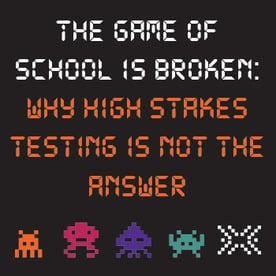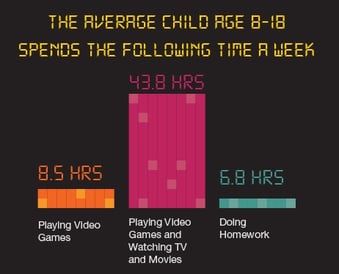 Imagine a school so great that children pop out of bed begging to go there. A school that fully engages its students, who excel in every subject because they’re having fun. A school where the final bell of the day makes the students sad, because they have to leave.
Imagine a school so great that children pop out of bed begging to go there. A school that fully engages its students, who excel in every subject because they’re having fun. A school where the final bell of the day makes the students sad, because they have to leave.
The feelings I just described are what children experience when they play a great video game. They are excited to play the game, they have a great time working through the puzzles and challenges, and they are sad when mom says, “Dinner is ready! Game time is over!” As a former video game fanatic, I like to use this metaphor to explain why student engagement should take priority over high stakes testing in the classroom.
Frequent challenges are the key to success Continuing the analogy, in a typical video game, players work their way through an environment, learning the rules of the game, and trying to master the basic skills to advance through the game. Along the way, they are put through small challenges to master specific skills. Once the requisite skills have been mastered, they move on to more complex skills, until they face the game’s final challenge. In order to finish the game, they will need to deploy all their newly learned skills.
Continuing the analogy, in a typical video game, players work their way through an environment, learning the rules of the game, and trying to master the basic skills to advance through the game. Along the way, they are put through small challenges to master specific skills. Once the requisite skills have been mastered, they move on to more complex skills, until they face the game’s final challenge. In order to finish the game, they will need to deploy all their newly learned skills.
Oh, and did I mention that along the way, the players are having so much fun that they are willing to do nothing else until the game is finished?
If you compare the video game scenario to student assessment and testing, you find very few commonalities. Instead of relying on one major, high stakes test to move students to the next level, we need to adopt the game mentality of many small tests that lead to rewards and motivate students to continue. We should focus on finding a variety of ways to constantly assess and challenge students over the course of the year. In this way, we can gain a real understanding of what students have learned, identifying and filling in any knowledge gaps throughout the year, while keeping them engaged.
Build a better game Did you know that the average eight- to eighteen-year-old in the United States spends about 8.5 hours a week voluntarily playing video games? If you add in TV and movie consumption, this number rises to an astounding 43.8 hours per week! Compare these numbers to the average 6.8 hours students spend on homework each week, and it’s clear that we’re doing something wrong. If we could find some way to motivate students in the same way a video game motivates players, we could possibly turn the tide on the amount of time students voluntarily spend learning.
Did you know that the average eight- to eighteen-year-old in the United States spends about 8.5 hours a week voluntarily playing video games? If you add in TV and movie consumption, this number rises to an astounding 43.8 hours per week! Compare these numbers to the average 6.8 hours students spend on homework each week, and it’s clear that we’re doing something wrong. If we could find some way to motivate students in the same way a video game motivates players, we could possibly turn the tide on the amount of time students voluntarily spend learning.
A large part of a game designer's job is to keep players motivated through methods called motivation loops. Players start games excited, wanting to learn anything and everything the game has to offer. They get excited to learn something new while playing the game, and can’t wait to use the knowledge and skills to navigate the game. Designers focus on telling a story, engaging the players and keeping them entertained. The goal is not “just” to learn the skills and information necessary to progress through the game, but to have a great experience in every moment in the game.
The education system can learn a lot from game designers. We should be trying to build motivation systems into the education process so that students are engaged and excited about learning – not just learning in order to pass a test. We need to inspire them to “want to learn” by reading, collaborating with other students, and working on interesting projects. Churning out millions of kids each year with the exact same mindset and knowledge doesn’t prepare them for future success.
Gamifying the classroom Begin gamifying your classroom by experimenting with different methods for engaging and entertaining your students. Try the game designer’s approach of iterating. Talk to other teachers and look around for what is working for others to incorporate gamification into the classroom environment.
Begin gamifying your classroom by experimenting with different methods for engaging and entertaining your students. Try the game designer’s approach of iterating. Talk to other teachers and look around for what is working for others to incorporate gamification into the classroom environment.
The following resources provide some ideas on how to bring more “game-based” activities into your classroom:
- Two books discussing gamification theory and implementations
- A great TED talk on the subject here
- A course on gamification
- A couple of great infographics on gamification here and here.
- Some great technology to help you gamify your school. ;)
Summary
The goal of education should be to drive curiosity in students and prepare them for the workforce or college, not rote memorization or passing a multiple-choice test. To find and drive passion for learning and to teach real-world skills, so that they can be successful in their chosen field and leave their mark on the world. The lifelong process of learning only starts in the classroom. Without extreme passion and interest, most students may graduate school thinking, “I have beaten the game!” when really the game of learning has just begun.
Have you had success gamifying your classroom? If so, we’d love to hear about it! Shoot us a tweet or leave a comment on our Facebook page.




